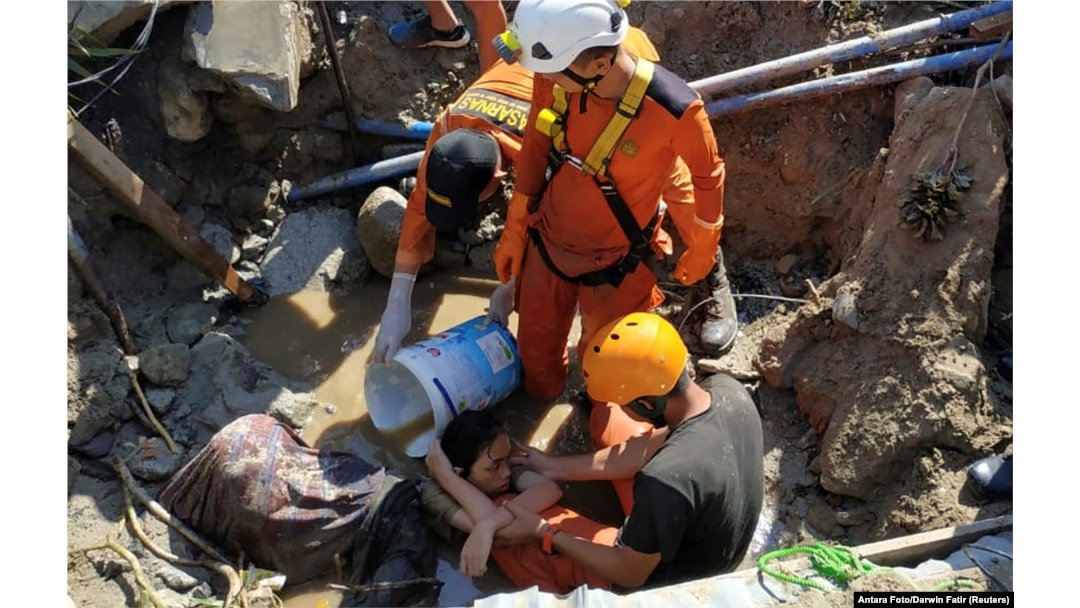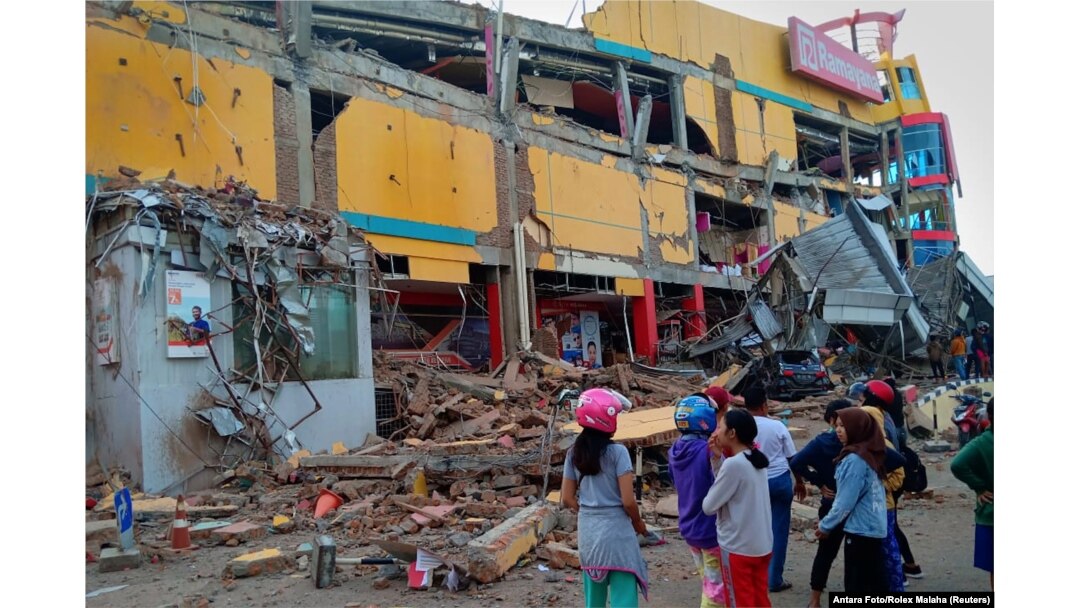The toll from an earthquake and tsunami in Indonesia soared Sunday to 832 confirmed dead, with authorities fearing it will only climb as rescuers struggle to reach outlying communities cut off from communications and help.
Dozens of people were reported to be trapped in the rubble of two hotels and a mall in the city of Palu, which was hit by waves as high as six meters (20 feet) following the 7.5 magnitude earthquake Friday.
Indonesian President Joko “Jokowi” Widodo toured Palu on Sunday.
“There are many challenges,” Jokowi said. “We have to do many things soon, but conditions do not allow us to do so.”

Search and rescue workers help rescue a person trapped in rubble following an earthquake and tsunami in Palu, Central Sulawesi, Indonesia, Sept. 30, 2018.
A young woman was pulled alive from the rubble of the Roa Roa Hotel, the news website Detik.com reported. Hotel owner Ko Jefry told Metro TV Saturday that up to 60 people were believed trapped. Hundreds of people gathered at the mall searching for loved ones.
“We’ve got information from people that their relatives are still inside, so we’re focusing on that, especially to find survivors,” a rescuer identified as Yusuf, working at the ruins of the mall, told Metro TV.

Residents stand in front of a damaged shopping mall after an earthquake hit Palu, Sulawesi Island, Indonesia, Sept. 29, 2018.
Bracing for more casualties
With most of the confirmed deaths from Palu, authorities are bracing for much worse as reports filter in from outlying areas, in particular, Donggala, a region of 300,000 people north of Palu and closer to the epicenter of the quake, and two other districts.
Vice President Jusuf Kalla said the toll could rise into the thousands.
National disaster mitigation agency spokesman Sutopo Purwo Nugroho told a news conference the affected area was bigger than initially thought, though rescuers only had good access to one of four affected districts: Palu.
“We haven’t received reports from the three other areas. Communication is still down, power is still out. We don’t know for sure what is the impact,” he said.
“There are many areas where the search and rescue teams haven’t been able to reach,” Nugroho said, adding that teams needed heavy equipment to move broken concrete.
Five foreigners, three French, one South Korean and one Malaysian, were among the missing, he said. The 832 fatalities included people crushed in collapsing buildings and swept to their death by tsunami waves.
Earthquake, Tsunami Strike Sulawesi Island, Indonesia
A disaster official said the tsunami traveled across the sea at speeds of 800 kph (500 mph) before striking the shore, and casualties could have been caused along a 300 km (200 miles) stretch of coast, north and south of Palu.
Donggala town has been extensively damaged, with houses swept into the sea and bodies trapped in debris, according to a Metro TV reporter on the scene.
The Red Cross said it had heard nothing from the Donggala region.
“This is extremely worrying,” it said in a statement. “This is already a tragedy, but it could get much worse.”
National search and rescue agency chief Muhammad Syaugi told Reuters rescuers were flying to Donggala by helicopter.
Finance Minister Sri Mulyani Indrawati said the government had allocated 560 billion rupiah ($37.58 million) for disaster recovery, media reported.
Sutopo Purwo Nugroho, a spokesman of Indonesia's disaster mitigation agency BNPB, holds a news conference to brief reporters on the latest situation after a strong quake and tsunami hit Sulawesi island, at the BNPB headquarters in Jakarta, Indonesia, Sept. 29, 2018.
Festival on the beach
Hundreds of people had gathered for a festival on Palu’s beach when the water smashed onshore at dusk.
Palu is at the head of a narrow bay, about 10 km long and 2 km wide, which had “amplified” the force of the wave as it was funneled toward the city, a geophysics agency official said.
A general view of Taman Ria's beach, which was hit by a tsunami after a quake in West Palu, Central Sulawesi, Indonesia, Sept. 30, 2018.
Questions about tsunami warnings
Indonesia is all too familiar with deadly earthquakes and tsunamis. In 2004, a quake off Sumatra island triggered a tsunami across the Indian Ocean, killing 226,000 people in 13 countries, including more than 120,000 in Indonesia.
Questions are sure to be asked why warning systems set up around the country after that disaster appear to have failed Friday.
The meteorological and geophysics agency BMKG issued a tsunami warning after the Friday quake but lifted it 34 minutes later, drawing criticism it had withdrawn it too quickly. But officials said they estimated the waves had hit while the warning was in force.
The damage in Palu, Central Sulawesi, Sept. 30, 1980, after an earthquake and tsunami struck the area, killing hundreds of people and causing much destruction.
Questions have been raised about what caused the tsunami, with speculation an underwater landslide was to blame.
The BMKG said its closest sensor, about 200 km (125 miles) from Palu, had only recorded an “insignificant,” six-cm (2.5 inches) wave, while researchers said it was surprising the quake, which was recorded as a “strike-slip” event, when tectonic plates move horizontally against each other rather than vertically, had generated a tsunami.
“It may be that the shock of the quake triggered a landslide underwater, but we don’t have any proof yet,” Abdul Muhari, who heads a tsunami research team that advises the government, told Reuters.
Video footage on social media showed a man on the upper floor of a building shouting warnings of the approaching tsunami to people on the street below moments before the wave crashed ashore. Reuters was not able to authenticate the footage.
An aerial view of the city of Palu after an earthquake hit Sulawesi Island, Indonesia, Sept. 29, 2018.
Struggle to reach victims
The Head of the National Disaster Management Agency, Willem Rampangilei, told reporters in Sulawesi late Saturday that rescuers were struggling in their hunt for more victims.
“We are having difficulty deploying heavy equipment ... because many of the roads leading to Palu city are damaged,” he was quoted by the Kompas newspaper as saying.
About 10,000 displaced people were scattered at 50 different places in Palu, he said. Dozens of injured people were being treated in tents set up in the open.
Dead bodies are seen, Sept. 29, 2018, on a street after earthquake hit in Palu, Indonesia.
‘Horrifying’
Photos confirmed by authorities showed bodies lined up on a street on Saturday, some in bags and some with their faces covered by clothes.
President Joko Widodo was scheduled to visit evacuation centers Sunday.
Australian Prime Minister Scott Morrison said Indonesia had not asked for help but he had contacted President Widodo overnight to offer support and deep sympathies.
“It is horrifying. ... If he needs our help, he’ll have it,” he told ABC TV’s Insiders program.
The military has started sending in aircraft with aid from Jakarta and other cities, authorities said.
Palu’s airport was damaged in the quake, but had reopened for limited commercial flights, authorities said.
Indonesia sits on the Pacific Ring of Fire and is regularly hit by earthquakes.
In August, a series of quakes killed more than 500 people on the tourist island of Lombok, hundreds of kilometers southwest of Sulawesi.


